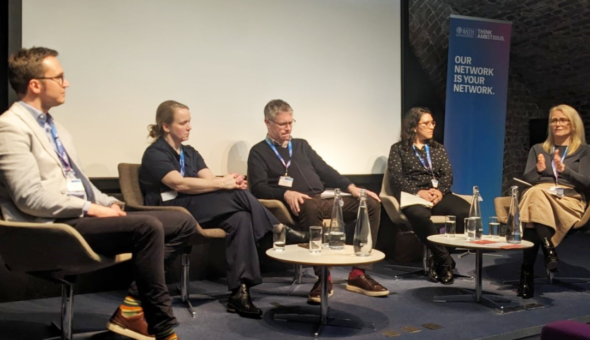Dr Luke Fletcher (University of Bath) and Dr Rosa Marvell (University of Portsmouth) discuss their latest research that explores allyship as a promising framework that can promote the inclusion of transgender and non-binary people in the workplace.
Transgender and non-binary1 (or ‘trans’) people often face higher levels of prejudice, discrimination, and conflict in and out of the workplace, including higher rates of physical assaults. This may explain why many trans people are not fully open about their gender identity at work; often actively hiding their identity and being fearful of it being revealed. Employers have a moral and legal duty to protect their employees from psychological and physical harm. In many countries, there are specific employment protections as well as anti-discrimination initiatives that help prevent and deal with instances of prejudice, discrimination, and harm across a range of minority (or minoritised) groups. However, trans people are often not as well catered for by these legislations. As legal advancements take time to manifest and become embedded, it is critical that organisations foster a workplace climate that encourages a real sense of inclusion and empowerment for a range of discriminated groups, particularly for trans people.
Why a strong diversity and inclusion climate matters
In our recently published paper, we look at how such a workplace climate of diversity and inclusion can encourage colleagues who are more predisposed to prejudicial attitudes to be more willing to learn about, and be more willing to show, allyship towards trans people in their workplace. In an online survey 209 heterosexual, cisgender2, UK-based workers were presented with a realistic work scenario where they were informed that one of their work colleagues wanted people to know they were trans and were going to change the way they presented themselves at work, e.g., appearance, pronouns etc. We found that, although those with an inclination towards inequality and social hierarchy had weaker intentions to show allyship to that trans worker, they were more likely to do so when they perceived that they were working in organisation with a strong diversity and inclusion climate.
Such a climate is reflected when there is a shared perception, for example, that the organisation makes it easy for people from diverse backgrounds to fit in and be accepted; that managers demonstrate through their actions that they want to hire and retain a diverse workforce; that people share and learn about one another; and that employees appreciate the differences that a diverse collection of people bring to the workplace. Importantly, a strong diversity and inclusion climate creates a framework of social norms that reduces dominant power dynamics and highlights the value of social justice, equality, and fairness. It not only helps determines what is (un)acceptable behaviour in the organisation, but also provides incentives and social acceptance to employees for engaging in, and demonstrating, allyship to others. Therefore, organisations that actively implement strong inclusion and diversity practices may help bring along colleagues who might otherwise have been reticent about supporting trans people openly.
What is allyship?
A key concept in the paper is that of allyship, which has a varied range of definitions and meanings across different literatures. However, there is some consensus that allyship broadly means actively supporting and standing up for a specific minority or minoritised3 group. In the context of trans workers, we focus on allyship that relates to three core aspects:
- providing active support to trans workers
- being willing to stand up for trans workers
- being identified as an ally to trans workers
At its core what we mean is explicit, active solidarities which listen and attend to the needs of trans workers. Ultimately, it is the demonstrable behaviours that matter and make a difference - allyship needs to be more than a passive act or self-determined label (e.g., I consider myself an ally to trans people) such that it also is perceived as allyship by the people it seeks to have a positive impact on.
How allyship can promote the wellbeing of trans workers
Importantly in our paper, we conducted a second study to look at the potential psychological effects that allyship, when perceived as such, may have for trans workers themselves. In an online survey of 196 trans workers, based in the UK, we found that the stronger the perception of allyship from heterosexual, cisgender colleagues the more likely they were to be engaged with their work and be more satisfied with their life in general. We also showed that these links were driven by a sense of psychological safety and authenticity. This underscores how allyship can promote the wellbeing of trans workers as it helps create an atmosphere where trans people can feel able to express their true thoughts and feelings as well as their authentic selves without fear of negative repercussions.
Facilitating allyship in the workplace is not just a moral good that supports inclusion efforts in an organisation, but it also has a very strong psychological benefit for minority groups. Allyship can be a win-win for employees and their employer, but it must be carefully considered and have an authentic, deep meaning to the organisation. We provide some useful suggestions and links to other resources (and expert organisations) about how allyship, particularly for trans workers, can be encouraged in our companion piece in The Conversation (co-authored with Dr Deborah Brewis).
1 We define transgender people as those who live their lives identifying as and expressing a different gender than the one assigned to them at birth, including non-binary identities which reflects when a person does not identify as a fixed/enduring way as male or female.
2 Cisgender refers to people whose sense of personal gender identity corresponds with the gender they were assigned at birth.
3 The term minority tends to refer to distinct statistical minority social groups in a given society, whereas minoritised signifies how groups can be subordinated through the processes of power and domination by other groups.
Read more about Luke's research in this press release.
Respond



